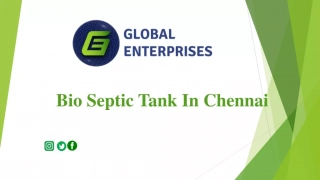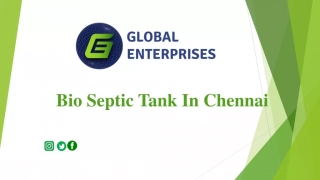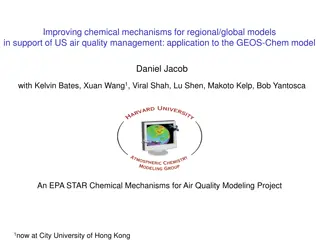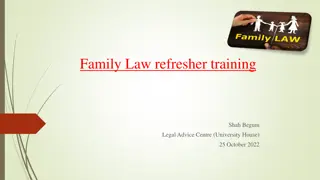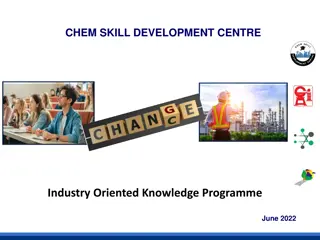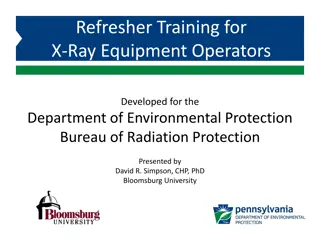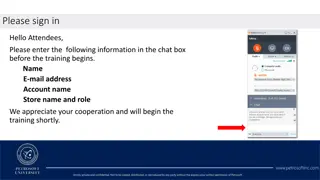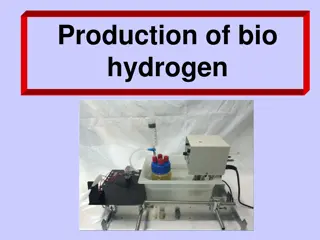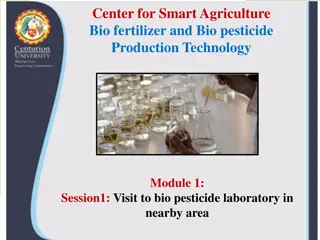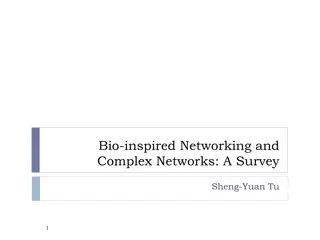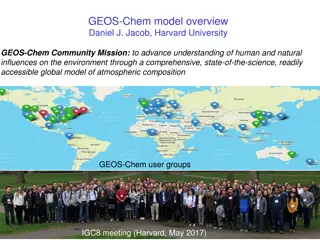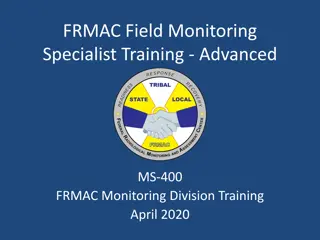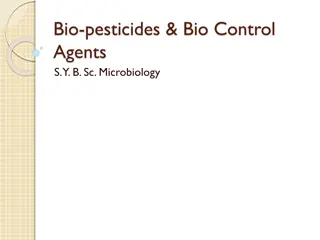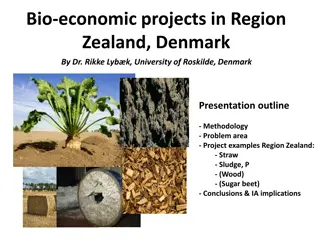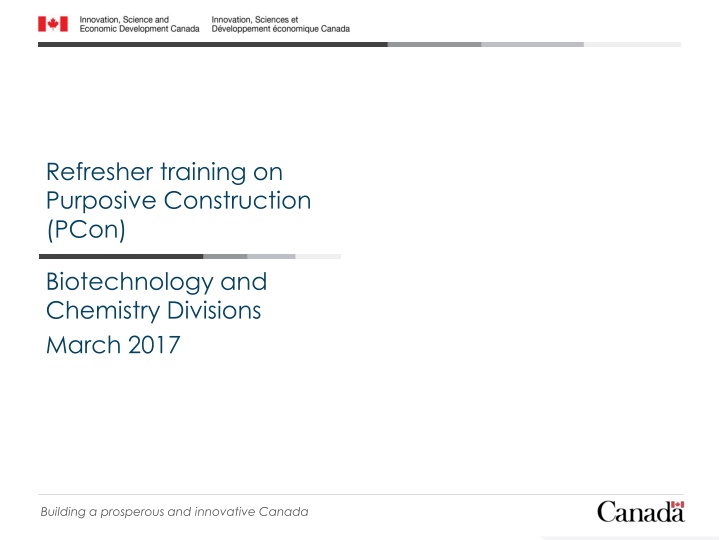
Purposive Construction in Biotechnology and Chemistry Divisions
Explore the refresher training on Purposive Construction (PCon) led by Dr. Steven Bryant, delving into the fundamentals, lessons learned, and application of PCon in solving problems effectively. Discover the two key purposes of purposive construction, when and how to apply PCon, and determining compliance through the PCon path. Dive into essential elements and exclusions in claim analysis for statutory compliance.
Download Presentation

Please find below an Image/Link to download the presentation.
The content on the website is provided AS IS for your information and personal use only. It may not be sold, licensed, or shared on other websites without obtaining consent from the author. If you encounter any issues during the download, it is possible that the publisher has removed the file from their server.
You are allowed to download the files provided on this website for personal or commercial use, subject to the condition that they are used lawfully. All files are the property of their respective owners.
The content on the website is provided AS IS for your information and personal use only. It may not be sold, licensed, or shared on other websites without obtaining consent from the author.
E N D
Presentation Transcript
Refresher training on Purposive Construction (PCon) Biotechnology and Chemistry Divisions March 2017 Dr. Steven Bryant, Canada Excellence Research Chair at the University of Calgary Building a prosperous and innovative Canada
Scope of this training Review of the basics Similar to the training already offered to Mechanical and Electrical Further training coming in spring 2017 Lessons learned from the last years of PCon For all divisions No examples of medical uses or diagnostic methods These will be the topic of a supplemental training session 2
Refresher training: Purposive construction (PCon) A quick review 3
The two purposes of purposive construction of claims Determine the meaning of terms and expressions used in the claim Determine which elements of the claim are essential to solve the problem 4
When to apply PCon? Every time! But it may be done automatically and implicitly Even if written out during examination, it only needs to be included in the report if it is relevant to an examination issue Remember : in reports, the PCon analysis is written above the "defect line", it is not a defect. 5
How to apply PCon? In theory, it is done claim by claim. In practice, it is often more practical to start out using a single problem-solution set and to lump similar claims in the same analysis. 6
Determining S.2 compliance through the PCon path POSITA ? POSITA=Person of ordinary skill in the art CGK=Common general knowledge CGK ? Problem ? Solution ? If at least one EE is statutory, claim is considered statutory, unless one EE is an exclusion Essential elements (EEs) to solve the problem? Are EEs statutory ? (complies with section 2): Exclusion = method of medical treatment or higher life form 7
Determining S.2 compliance through the PCon path Why would a claim be non-statutory? No essential element from a category of invention Abstract method, calculation type invention The computer is not an essential element to solve the problem One of the essential elements is an exclusion Method of medical treatment, higher life form The element is essential to solve the problem
Are the essential elements statutory? POSITA ? CGK may be used when making decisions in this zone CGK ? Problem ? Solution ? CGK is NOT allowed when making decisions in that zone "Contribution" fault! If at least one EE is statutory, claim is considered statutory, unless one EE is an exclusion Essential Elements (EEs) ? Are EEs statutory ? (complies with section 2): 9
Reminder: CGK During PCon analysis Yes for Determination of the Problem CGK Determination of Essential Elements No for A CGK element can be essential 10
Reading the specification and prior art Lens of their CGK Specification or prior art POSITA The POSITA reads the specification (and the prior art) through the lens of their CGK. 11
How to determine if an element is essential? Is it essential to solve the problem identified? We do not apply the Free World Trust (FWT) decision strictly in our examination PCon FWT decision was made for granted patents, not applications Often argued by agents to contest our practice, but It is notthe applicant s intent which determines essentiality, it is the examiner s judgment if the POSITA would consider the element essential. Having an effect on the invention is not sufficient to be essential It needs to be essential to solve the problem 12
Arguing that an element is not essential Element not essential because it is known/CGK determined based on the application and CGK. it is not part of the solution to the problem 13
We will now work on a case study with the same claim but different CGK scenarios EFFECT OF CGK 14
Prior art vs CGK Prior art document(s) No effect on purposive construction No effect on Section 2 irregularity No direct effect on compliance CGK elements Can inform the identification of the problem to be solved with Section 2, informs the identification of the problem to be solved, may result in a solution that is outside the scope of S.2 Can also be used for anticipation and obviousness Can be used for anticipation and obviousness 15
Prior art vs CGK Example 1: published genome sequence The full-length sequence of the genome has been publicly known for years Yet the POSITA might not recognize what each portion of the full-length sequence does i.e. even though the full-length sequence is CGK, the different portions of the full-length sequence which may be of particular interest are still not CGK. 16
Prior art vs CGK Example 2: publication in Nature An article may have a lot of visibility, for example after a publication in one of the most read magazines But its content might not be recognized by the POSITA in that field Controversial article, etc. 17
Case study 1: scenario 1 Scenario 1 Claim 1: A method to determine porosity of a bone in a patient, comprising scanning using an IR source and detector, wherein porosity is calculated using EQUATION 2. POSITA Background/CGK: IR source and detector are CGK, but not used to measure bone porosity Note that this is NOT a diagnostic method as per the practice notice: there is NO correlation. Is it a measurement method. 18
Case study 1: scenario 1 Problem: No existing method to measure bone porosity in a patient Solution: Scanning using IR source and detector, and calculating using EQUATION 2. Essential Elements: Scanning using IR source and detector, and calculating using EQUATION 2. Statutory?: Yes, because scanning using IR source and detector is from a category of invention. Note that even if the IR source and detector are part of the CGK, they are part of the essential elements 19
Case study 1: scenario 2 Same claim, alternative CGK Scenario 2 Claim 1: A method to determine porosity of a bone in a patient, comprising scanning using an IR source and detector, wherein porosity is calculated using EQUATION 2. Background/CGK: Use of IR for measuring bone porosity is known and is CGK but a different equation was used This application provides a new improved formula, EQUATION 2 20
Case study 1: scenario 2 Problem: Porosity calculation methods are not accurate Solution: Calculate using EQUATION 2 when performing IR analysis (using the information from IR scanning) Essential Elements: Calculate using EQUATION 2 Statutory?: No- Abstract; not a category of invention. Does not comply with Section 2. Note- The CGK influenced the determination of the problem from the POSITA s perspective 21
Case study 1: scenario 3 Same claim, alternative CGK Scenario 3 Claim 1: A method to determine porosity of a bone in a patient, comprising scanning using an IR source and detector, wherein porosity is calculated using EQUATION 2 Background/CGK: Use of IR for measuring bone porosity using EQUATION 2 has been published, but it is not yet part of the CGK 22
Case study 1: scenario 3 Problem: No existing method to measure bone porosity in a patient Solution: Scanning using IR source and detector, and calculating using EQUATION 2 Essential Elements: Scanning using IR source and detector, and calculating using EQUATION 2. Statutory?: Yes Notes- PCon analysis is the same as in Scenario 1. Since it was not CGK to use IR to analyze a bone, it was still a problem that needed to be solved in the art. However, one needs to consider the effect of prior art: the claim could be anticipated or obvious in light of the single piece of prior art. 23
Part 2: Effect of the description on the problem; presence of a computer Inspired by EB 2015-CD3-G (CD1380) 24
Example 2 1. A method of determining when a patient's next dose of drug X is required, comprising: providing to a computer the blood concentration level of drug X in a patient's blood stream at a first point in time and a second point in time; causing the computer to plot the drug concentration level in the patient's blood at various times based on the information provided; and causing the computer to calculate the patient's next required dose using algorithm A. 25
Example 2, scenario 1 Application states that: the problem is how to improve known methods of determining a patient's next dose of drug X, known methods are prone to overdosing and underdosing. Current CGK methods: taking information about drug concentrations in the patient's bloodstream at two different points in time and using the levels to calculate the patient's next dose using a CGK algorithm (manually or using a computer). By using new algorithm A instead of the CGK algorithm, the calculated dose is more accurate. There are no teachings or technical details that suggest a computer problem was solved. 26
Example 2, scenario 1 Examiner determines that: The POSITA is from the fields of pharmacology and computer sciences The POSITA s CGK includes taking information about drug concentrations in a patient's bloodstream at two different points in time and using the levels to calculate the patient's next dose using the CGK algorithm (manually or using a computer). The problem to be solved is to provide more accurate dosing for a patient in order to reduce underdosing and overdosing. The solution the applicant has come up with is to use algorithm A in the calculation of a patient's next dose. 27
Example 2, scenario 1 Examiner determines that: The essential elements in this scenario are therefore the elements which lead to the more accurate dose: calculating the patient's next dose using new algorithm A. 28
Example 2, scenario 1 Is the claim statutory? In this scenario, the only essential element is calculating the patient's next dose using new algorithm A. It is merely data manipulation amounting to a disembodied idea without practical application. Therefore the claimed subject-matter is non- statutory. 29
Example 2, scenario 1 Is the computer essential? The skilled person would consider that the computer is not an essential element; the computer does not participate in the solution to the problem. The skilled person would understand the problem being addressed by the application is not a computer problem related to the implementation of new algorithm A. Although the computer is part of the operating embodiment of the claim, the computer does not actually change the nature of the solution to the identified problem. 30
Example 2, scenario 2 Same claim as scenario 1, but the description is different 31
Example 2, scenario 2 Applicant states that: Current CGK methods: taking information about drug concentrations in the patient's bloodstream at two different points in time and using the levels to calculate the patient's next dose using a CGK algorithm. 32
Example 2, scenario 2 Applicant states that: the problem is how to improve known methods of determining a patient's next dose of drug X, known methods are prone to overdosing and underdosing. By using new algorithm A instead of the CGK algorithm, the calculated dose is more accurate. This is like scenario 1 33
Example 2, scenario 2 Applicant states that: In addition, the manual calculation of a patient's subsequent dose is done incorrectly 10% of the time, leading to a 3% patient mortality rate. The applicant's solution to that problem is to automate the process. This has reduced the error rate to 1% (still some human error in inputting the data) and has reduced the patient mortality rate from 3% to .02%. 34
Example 2, scenario 2 Examiner determines: The problem was high error and mortality rates resulting from carrying out the manual calculations. The solution is to automate the manual conventional process using a computer and to use algorithm A. The essential elements are: providing the computer with data about drug levels at different points in time; causing the computer to plot the patient's blood drug concentration levels at various times; causing the computer to calculate the patient's next dose using algorithm A. 35
Example 2, scenario 2 Is the computer essential? It is essential to the successful solution of the problem in this scenario using the computer to carry out the calculations results in a reduction in the error rate in calculating when the next dose is required resulting in a reduced patient mortality rate, It is therefore an essential element of the claim. As the computer is an essential element of the claim, it follows that the claimed subject-matter is statutory. Other patentability requirements must still be evaluated. 36
Example 2 The difference between the two scenarios lies in how the problem, and its solution, have been defined. 37
Back to scenario 1 In answer to the examiner s report What if the applicant raises the issue of the mortality rate because of errors in the manual calculations? It depends (ha!) The examiner can be convinced that this is a problem solved by the application, the examiner can change their PCon analysis But if there was nothing about this aspect in the description, it can only be inferred by the POSITA if it was part of their CGK The examiner makes the determination Then obviousnouss might be an issue 38
Resources to help you with PCon PCon Resource Before contacting them, write a first analysis by yourself Sandra Hurley Christine Teixeira Cara Weir Practice group Heather Hurley Jeremy McLean 39
Slide Credits Marc De Vleeschauwer Seema Bissoon-Haqqani (for the Mech version) Jeremy McLean, Heather Hurley, Cara Weir, Christine Teixeira and Marie Quinn for comments 40

